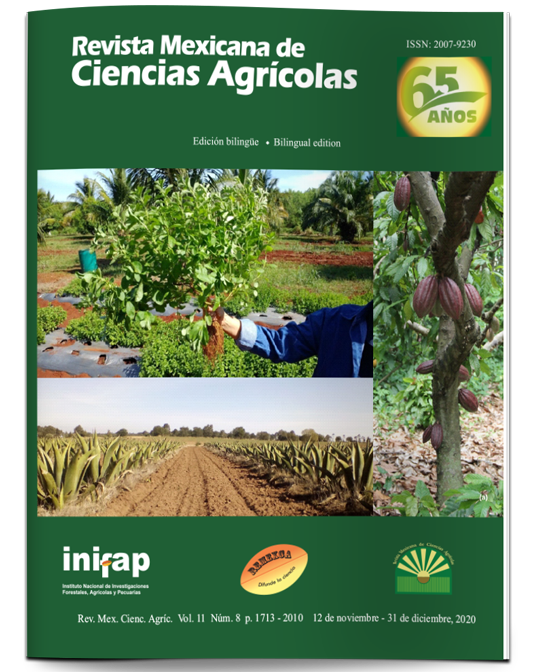Yield stability and physicochemical characteristics of grain of corn hybrids in High Valleys of Mexico
.
DOI:
https://doi.org/10.29312/remexca.v11i8.1990Keywords:
hybrids and flotation index, hybrid-environment, starchAbstract
Corn grain crops in High Valleys of Mexico generally do not meet quality requirements for use in the tortilla and dough industry. New hybrids have been released by research centers for these agroecological conditions and it is necessary to evaluate the stability of production and grain quality in different production environments to avoid rejection in the market. The objective of this study was to identify stable hybrids in their yield, physical-chemical characteristics of the grains and quality of tortillas. Ten hybrids were evaluated in five different environments with four replications for each treatment. The data were analyzed with SAS, version 9.0, the Anova was developed and the comparison of means was made with the Tukey test at 5%. Significant
differences were detected for hybrids, environment and hybrid*environment interaction; for grain yield, physical-chemical variables of the tortillas. The grain yields ranged from 9 to 12.4 t ha-1. The highest stability due to adaptability and yield by environments was found for hybrids H-70, H-66 and Tsiri Puma. Within the group of hard grains are the Tsiri Puma and the commercial control Albatros. The Atziri Puma hybrids, in Temascalcingo and H-50 in Atlacomulco, presented the largest grains. Correlations were found between proteins vs oil (r= 0.6), oil vs starch (r= -0.86) and proteins vs starch (r= -0.82). The highest dough yield was found in the H-51 AE hybrid, followed by H-47 AE, Albatros and Tsiri Puma with 2 kg of dough for each kg of nixtamalized corn. The yield and quality of tortillas of the hybrids evaluated comply with the values demanded by the industry. The results of this research allow us to recommend these new hybrids, due to their stability in yield, in the test environments, commercial quality of the grain and quality of their tortillas.
Downloads
Published
How to Cite
Issue
Section
License
Copyright (c) 2020 Revista Mexicana de Ciencias Agrícolas

This work is licensed under a Creative Commons Attribution-NonCommercial 4.0 International License.
The authors who publish in Revista Mexicana de Ciencias Agrícolas accept the following conditions:
In accordance with copyright laws, Revista Mexicana de Ciencias Agrícolas recognizes and respects the authors’ moral right and ownership of property rights which will be transferred to the journal for dissemination in open access. Invariably, all the authors have to sign a letter of transfer of property rights and of originality of the article to Instituto Nacional de Investigaciones Forestales, Agrícolas y Pecuarias (INIFAP) [National Institute of Forestry, Agricultural and Livestock Research]. The author(s) must pay a fee for the reception of articles before proceeding to editorial review.
All the texts published by Revista Mexicana de Ciencias Agrícolas —with no exception— are distributed under a Creative Commons License Attribution-NonCommercial 4.0 International (CC BY-NC 4.0), which allows third parties to use the publication as long as the work’s authorship and its first publication in this journal are mentioned.
The author(s) can enter into independent and additional contractual agreements for the nonexclusive distribution of the version of the article published in Revista Mexicana de Ciencias Agrícolas (for example include it into an institutional repository or publish it in a book) as long as it is clearly and explicitly indicated that the work was published for the first time in Revista Mexicana de Ciencias Agrícolas.
For all the above, the authors shall send the Letter-transfer of Property Rights for the first publication duly filled in and signed by the author(s). This form must be sent as a PDF file to: revista_atm@yahoo.com.mx; cienciasagricola@inifap.gob.mx; remexca2017@gmail.
This work is licensed under a Creative Commons Attribution-Noncommercial 4.0 International license.



